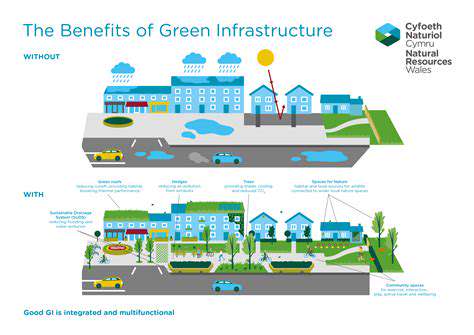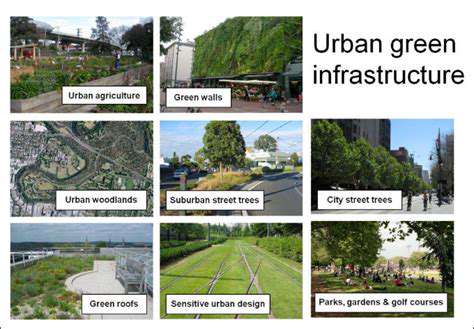Innovative Approaches to Green Infrastructure for Sustainable Urban Development
What is Green Infrastructure?
Definition and Importance
Green infrastructure refers to a network of natural and semi-natural systems that provide essential services to urban environments. This includes parks, gardens, green roofs, and urban forests, which not only enhance the aesthetic value of cities but also improve air quality, biodiversity, and climate resilience. By integrating natural elements into urban planning, cities can create healthier living spaces for residents.
The importance of green infrastructure lies in its ability to mitigate the effects of urbanization. As cities grow and develop, they often experience issues like flooding, heat islands, and loss of biodiversity. Green infrastructure offers sustainable solutions that address these challenges while promoting environmental sustainability and public health.
Types of Green Infrastructure
There are various types of green infrastructure that cities can implement to support sustainable development. These include green roofs and walls, which help in thermal regulation and reduce stormwater runoff, and permeable pavements that allow water to infiltrate the ground, minimizing flooding risks. Additionally, urban parks and community gardens play a vital role in enhancing local food security and fostering community engagement.
Other notable types include tree canopies that provide shade and improve air quality, as well as constructed wetlands that effectively filter pollutants in stormwater. By diversifying the types of green infrastructure, urban planners can create multi-functional spaces that foster ecological balance and social interaction.
Benefits of Green Infrastructure
The implementation of green infrastructure in urban areas yields numerous benefits for both the environment and the community. Ecologically, it supports biodiversity by creating habitats for various species and improving overall ecosystem health. Socially, access to green spaces is linked to improved mental health, increased physical activity, and enhanced community interaction.
Furthermore, green infrastructure can lead to economic savings by reducing the costs associated with stormwater management and energy use. Sustainable urban development driven by green infrastructure can thus not only improve quality of life but also provide a significant return on investment for municipalities.
Challenges and Future Directions
Despite the numerous advantages, the implementation of green infrastructure faces challenges such as funding limitations, land use conflicts, and regulatory barriers. Urban planners and policymakers must navigate these obstacles while advocating for the importance of green infrastructure in the context of sustainable development.
Looking ahead, there is a growing need for innovative financing models, community involvement, and interdisciplinary collaboration to enhance the effectiveness of green infrastructure initiatives. The integration of technology, such as smart sensors and data analytics, can also optimize the management and maintenance of these green systems, paving the way for more resilient cities in the future.
The Benefits of Green Infrastructure

The Environmental Impact of Green Infrastructure
Green infrastructure plays a crucial role in managing stormwater and improving air quality. By integrating natural systems into urban environments, cities can significantly reduce pollution and mitigate the effects of climate change.
Moreover, the presence of green spaces can enhance biodiversity by providing habitats for various species. This not only supports local ecosystems but also helps urban areas become more resilient to environmental challenges.
Economic Advantages of Implementing Green Infrastructure
Investing in green infrastructure can lead to significant long-term savings for municipalities. For instance, reducing the need for costly grey infrastructure, such as traditional drainage systems, allows cities to allocate funds to other critical areas.
Furthermore, green infrastructure projects can increase property values and attract businesses, making urban areas more economically vibrant. This creates a win-win scenario for both city planners and residents alike.
Social Benefits and Community Well-being
The integration of green infrastructure improves the overall quality of life for urban residents. Access to parks, gardens, and green roofs provides spaces for recreation and relaxation, promoting physical and mental well-being.
In addition, communities with more green infrastructure tend to experience lower crime rates and higher social cohesion. This fosters a sense of belonging and enhances community engagement, creating healthier urban environments for all inhabitants.
Successful Examples of Green Infrastructure

Case Study: The High Line in New York City
The High Line is an elevated linear park built on a former railway track that runs through Manhattan. This project transformed an urban eyesore into a vibrant green space, attracting millions of visitors each year. It creatively integrates gardens, public art, and walking paths into the cityscape. The High Line has not only become a recreational area but has also spurred economic development in the surrounding neighborhoods. The successful implementation of the High Line has inspired similar projects in various cities worldwide.
A key feature of the High Line is the use of native plant species which require less water and maintenance. This focus on sustainability is crucial for urban areas facing climate change challenges. The park also incorporates stormwater management systems to minimize runoff and improve water quality. Strong community engagement played a vital role in its planning and design, ensuring that the space met the needs and desires of local residents. Overall, the High Line serves as a powerful example of how urban green spaces can enhance both ecological health and community well-being.
In conclusion, the High Line demonstrates the potential of innovative green infrastructure to revitalize urban environments. It showcases the ability to combine recreation with ecological benefits, making it a model for future developments. As cities continue to grow, the lessons learned from the High Line will be essential for promoting sustainability. It illustrates the importance of creativity and collaboration in urban planning.
Green Roof Initiative in Chicago
Chicago has implemented a successful green roof initiative to tackle urban heat and improve air quality. These living rooftops not only provide insulation for buildings but also act as stormwater management systems. By absorbing rainwater and reducing runoff, green roofs play a significant role in urban flood prevention. The initiative encourages building owners to adopt eco-friendly practices and has led to the construction of over 600 green roofs across the city.
This initiative has a positive impact on local wildlife by creating habitats in an otherwise concrete landscape. Additionally, these green spaces improve the overall aesthetic of the city and enhance the quality of life for residents. The city offers incentives for developers to include green roofs in new construction, which has garnered widespread support. The integration of green roofs into urban planning is a crucial step toward sustainable development and resilience against climate change.
Furthermore, the Chicago green roof initiative is supported by extensive research showcasing its benefits. Studies have shown that green roofs can significantly lower building energy costs and improve air quality. As cities around the globe face similar challenges, Chicago's approach can serve as a blueprint for others aiming to incorporate green infrastructure. The initiative reflects a growing recognition that environmental health is closely tied to urban living.
Challenges to Implementation
Identifying Common Barriers
Implementing green infrastructure in urban settings often encounters numerous challenges that can hinder progress. One significant barrier is the lack of funding and resources designated for green projects. Many municipalities operate under tight budgets, sidelining long-term sustainability efforts in favor of more immediate economic needs.
Another common challenge is the regulatory environment. Existing zoning laws and building codes may not support the integration of green infrastructure, making it difficult for developers and city planners to innovate. Adjusting these regulations to accommodate new green solutions requires considerable effort, often met with institutional inertia.
There is also the challenge of public perception and community engagement. Many residents may not understand the benefits of green infrastructure, leading to resistance or apathy. Successful implementation often requires substantial outreach and education to foster community buy-in and support for proposed initiatives.
Strategies for Overcoming Challenges
To address financial constraints, cities can explore alternative funding sources such as public-private partnerships, grants from environmental organizations, and crowdfunding initiatives. These avenues can help create a financial buffer for the project, enabling the initial development of green infrastructure features.
Adapting existing regulations to accommodate green infrastructure is equally important. Urban planners and policymakers can work together to revise zoning laws and building codes, making it easier to incorporate sustainable practices. Pilot projects showcasing the benefits of green solutions can serve as models for wider adaptation in policy.
Engaging the community in the planning and implementation process can help consolidate public support for green infrastructure projects. Encouraging public participation through workshops, surveys, and informational sessions can educate residents about the benefits of these initiatives and address any concerns they may have, fostering a sense of ownership and pride in the projects.